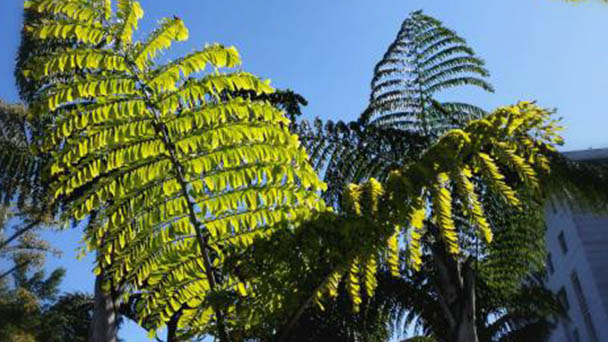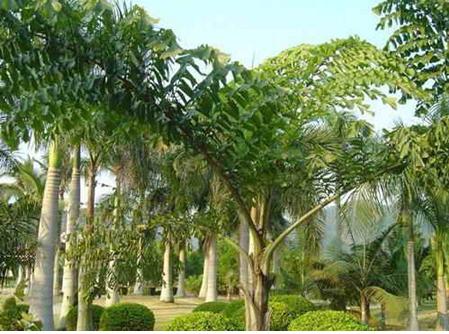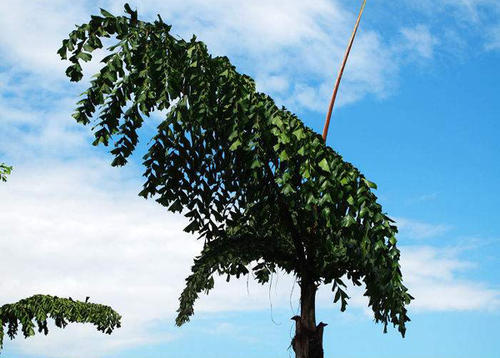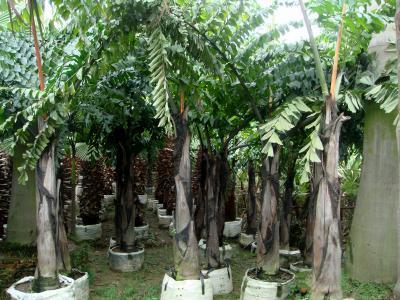Fishtail Palm (Caryota Urens) Profile
Written by Maggie
Nov 12 2021

Fishtail Palm (Caryota urens), also called Jaggery Palm, Toddy Palm, Fishtail Wine Palm, is an evergreen tree in the Palm family. Fishtail Palm natural resources are scarce, for the national rare large palm plants belong to the secondary protection plants. Its single straight, beautiful tree shape, four seasons evergreen, is the tropical, south subtropical excellent ornamental tree species.
Fishtail palm picture

Fishtail palm info
| Botanical Name | Caryota urens |
| Common Names | Fishtail palm, Jaggery Palm, Toddy Palm, Fishtail Wine Palm |
| Plant Type | Tree |
| Light | Full Sun, Sun to Partial Shade, Light Shade, Partial to Full Shade |
| Native Areas | E. Asia - India, Sri Lanka. |
| USDA hardiness | 9-12 |
| Foliage | Evergreen |
| Mature size | over 40 ft. (12 m) high, 8-10 ft. (2.4-3 m) wide |
Morphological characteristics of fishtail palm
Fishtail Palm is arboreal, 5 to 25m high, 25 to 45cm in diameter, dark brown stem, enlarged or not enlarged into a vase, not covered with white felt-like villi on the surface, with obvious annular leaf marks.
Leaves of fishtail palm are 5 -- 7m long, 3 -- 5m wide, arched downward;Pinnae broadly cuneate or narrow inclined wedge, 15 to 29 cm long, 5 ~ 20 cm wide, young leaves nearly leathery, old leaves thick leathery, the lower pinnae close to the branches and leaves the base of the shaft, margin rules tooth missing, base gradually into the throat of feather above cuneate, straight edge, diagonal stretch or around the inner arc QuCheng irregular tooth deficiency, and extends to the caudate acuminate, the top 1 pinnae broadly cuneate, apex 2 ~ 3 crack; Petiole of fishtail palm is 1.3 -- 2m long, abaxially convex, concave above, base ca. 5cm in diameter, exfoliated brown-black felt-like tomentose; Leaf sheath margin with reticulate brown-black fibers.
Buddha spa the of fishtail palm length 30 ~ 45cm; Inflorescences are 1.5 -- 2.5m long, with many densely spiked branches, 1 -- 1.8m long;Peduncle cylindrical, stout, 5 ~ 75 cm in diameter, bracts densely covered tile pattern, male calyx and petals to the loss of dark brown felty hairs, sepals suborbicular, cover sepals more than covered the lateral sepals, not verrucous convex surface, margin semicircle tooth, stamens (30 ~) 80 ~ 100, filaments short, nearly white, anthers linear;Female flowers are similar to male flowers, but calyx is slightly wider, petals are shorter, stamens 3, ovary obovate triangulate, stigma sessile, 2-lobed. Fruit of fishtail palm is spherical to oblate, 1.5 -- 2.4cm in diameter, red when ripe. A fishtail palm has 1-2 seeds, subglobose or hemispherical, endosperm chewy.
Go it alone. With conspicuous annular leaf marks, sometimes thickening in the middle into a bottle.2 pinnately lobed long leaves, about 8 gathered on dry apex, flat and neat, leaflet fin-shaped. Panicles of fishtail palm are axillary, 2-6m long, pendulous. Berry globose, red to blackish brown as ripe.
A fishtail palm is an evergreen palm-shaped tree, 10 -- 20m tall, 30 -- 70cm in diameter at breast height, trunk usually enlarged like a bottle, with annular leaf marks. Leaves are clustered at the top, two pinnatifid compound leaves, 5.5 ~ 6.6m long, 2.6 ~ 4m wide, petiole stout, leaf sheath petiole and leaf axis are covered with black brown chaff scales.
The pinnae of fishtail palm are 20 to 24 pairs, 1.3 to 2m in length, with 23 to 27 pinnae on each side. They are oblique wedge-shaped, the margin has a rodent notch of varying size, and the top one is wide wedge-shaped with 2 or 3 lobes. Spices of fishtail palm are up to 2.5m long, pendulous, stout inflorescence axis, branching up to 400 ~ 500, 1 ~ 1.8m long; The flowers are very numerous, in 3 clusters, the female flowers in the middle, the male flowers on either side; Fishtail palm has 3 male sepals, ciliate, petals reddish, stamens 30 to 102; Female sepals are ciliate, corolla pale green, sterile stamens 3, ovary 2 locules, ovules solitary.
Fruit of fishtail palm is berrylike drupe, dark red when ripe, globose or oblate, 2 -- 2.4cm in diameter; Seeds are subglobose or hemispherical.
Read More:
12 Popular Evergreen Plants with Pictures for Beginners
Ecological habits of the fishtail palm
Fishtail palm is produced in China's southern Yunnan, Guangxi and southern Xizang, China's southern and southeastern provinces are planted. Fishtail Palm is fond of sunshine, high temperature and humid environment, tolerant to cold, and suitable temperature for growth is 20 ~ 28℃. To seed reproduction, soil requirements lose fertile, good drainage environments. Flowers about once in 20 years, the whole plant dies after flowering and fruiting .The life span is about 40 ~ 60 years.
The fishtail palm distribution area
Fishtail palm distributes in Guangxi, Yunnan and other provinces. Fishtail palm was born in the elevation of 370 ~ 1500(~ 2450) meters of limestone mountain areas or gully forest. India, Sri Lanka, Burma and Indo-China Peninsula are also found.

How to grow and care for fishtail palm
Moisture care
Fishtail palm likes a humid climate environment, the relative temperature of air in the growth environment is required to be 70 ~ 80%. If the relative humidity of air is too low, the leaf tip will dry up.
Temperature care
Because Fishtail palm is native to tropical areas, like high temperature environment, winter temperature requirements are very strict, when below 10℃ growth is slow, began to enter a semi-dormant or dormant state; When the temperature is below 5℃, Fishtail palm can not be safely overwintering; In summer, temperatures above 35 ° C can also be tolerated, but growth is temporarily hampered. The optimum growth temperature is 18 ~ 30℃.
Light care
The light requirement of Fishtail palm is not strict, like full sun, also it can endure half shade, but grow better when full sun.
Water care
For potted plants, in addition to adding organic fertilizer on the pot, in the usual maintenance process, but also to carry out appropriate fertilizer and water management.
Spring, summer and autumn: these three seasons are the peak season for its growth. Fertilizer and water management cycle according to the sequence of "huabao" -- clear water -- "huabao" -- clear water, and the interval period is about 1-4 days.
Winter: In winter dormant period, it is mainly to control fertilizer and water. Fertilization and water management should follow the sequential cycle of "Huabao" -- clear water -- clear water -- "Huabao" -- clear water -- clean water. The interval period is about 3-7 days.For ground planted plants, apply fertilizer and water 2 ~ 4 times in spring and summer according to drought conditions: first open a small furrow 30 ~ 100cm away from the root neck (the larger the plant, the farther away from the root neck), with the width and depth of the furrow being 20cm.Sprinkle 25 ~ 50 jin of organic fertilizer, or 1 ~ 5 two particles of compound fertilizer (chemical fertilizer) into the ditch, and then pour on permeable water.After winter and before spring, apply fertilizer again according to the above method, but do not water.
Trim
Winter pruning: in winter Fishtail palm enters dormant or half dormant period, want thin, disease insect, dead, too close wait for branch to cut off.
As long as Fishtail palm is properly maintained, it will grow quickly. When it reaches a certain size, you should consider changing it to a larger pot so that Fishtail palm can continue to grow vigorously. The proportion of culture soil and components for changing pots can be selected as follows: garden soil: slag = 3:1; Or garden soil: medium river sand: sawdust = 4:1:2; Or paddy soil, pond mud, leaf rot soil in one of the.
To take off the pot
Put the pots of flowers on the ground and you want to change with slap dab around the basin, isolating the root trembled and the basin and wall, flower pot upside down on the left hand, left hand index finger and middle finger gently clamp plant, resist basin along the wrist and fingers, right hand slapping your pelvic floor, then use your thumb from the top down, bottom hole take root soil to plants come out. When removed, pat the soil gently with your palms to remove excess soil.
The purpose of the fishtail palm
Fishtail palm is an excellent street and shade trees of tropical regions. The Fishtail Palm trees are planted in courtyards, roadsides, and flower beds. They are tall and erect, with lush leaves, and are suitable for viewing throughout the year. Wood can be made into utensils. There are about 1 million palm plants in the monocotyledonous palm base in Jiangsu Province, which constitute part of the unique landscape of tropical plants with their unique morphological characteristics. Dicotyledonous plant palm tree, leaf sheath for fan type, in jiangsu palm base to provide the most palm fiber, leaves can make fans, hats and other handicrafts, root medicine.
Fishtail Palm is highly resistant to soot, sulfur dioxide, hydrogen fluoride and other harmful gases and has absorptive capacity, making it suitable for large-scale planting in areas with air pollution. In addition, Fishtail palm has many uses, tree trunk texture dense, hard outside and soft inside, moisture resistance and corrosion resistance, is an excellent building materials; The leaf sheath fiber can be used to make broom, brush, coir raincoat, pillow cushion, mattress, water tower filter screen, etc. Brown leather can be made of rope; Brown leaves can be used as canopy cover; Flower, fruit, Fishtail palm root and leaf base palm plate can be processed into medicine, mainly for treating golden sores, scabies, with collapse, hematochezia, dysentery and other diseases; The high melting point wax used in industry can be extracted from the seed wax skin. The seed kernel of Fishtail palm contains rich starch and protein, which can be used as livestock feed after grinding. The non flowering buds can also be eaten as vegetables.

Fishtail Palm - one of the best indoor trees
Latest Updated
- Benefits of Bugleweed - 7 Science-backed Health Benefits
- Bugleweed Dangers & Side Effects - Is It Poisonous?
- How to Plant Evergreen Trees - What You Should Know
- When to Plant Evergreens - Grow Guide for Evergreen Trees
- 12 Wonderful Evergreen Shrubs for Your Garden
- 12 Popular Evergreen Plants with Pictures for Beginners
- When And How To Prune A Lilac Bush Like a Pro
- How to Grow & Care for Lilac Vine (Hardenbergia Violacea)
- Japanese Lilac Tree (Syringa Reticulata) Care & Propagation Guide
- Shumard Oak Pros and Cons - What to Know
Popular Articles
- Winter maintenance of Antirrhinum Majus
- How to Grow Terminalia Mantaly Tree
- How to Grow and Care for Crossostephium Chinense
- How to grow Antirrhinum Majus in spring
- Peristeria Elata (Dove Orchid) Profile: Info & Care Guide
- Underwatered Snake Plant (Sansevieria Trifasciata) - Signs And How To Fix
- How to Care for Brazilian Jasmine Plant (Mandevilla Sanderi)
- How to Grow & Care for Graptopetalum Purple Delight in Summer
- Rosa Chinensis (China Rose): Plant Growing & Care Tips
- How to Care for Baby Sun Rose (Aptenia Cordifolia)